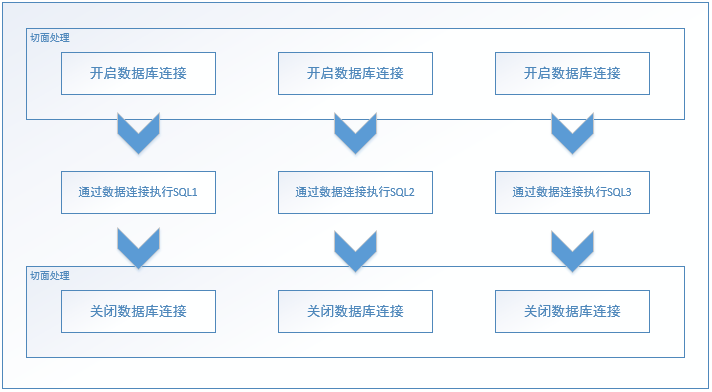《Java Spring框架》Spring切面(AOP)配置详解
1. Spring 基本概念
AOP(Aspect Oriented Programming)称为面向切面编程,在程序开发中主要用来解决一些系统层面上的问题,比如日志,事务,权限等待,Struts2的拦截器设计就是基于AOP的思想,是个比较经典的例子。
在不改变原有的逻辑的基础上,增加一些额外的功能。代理也是这个功能,读写分离也能用aop来做。
2. 原理图:

我们希望业务开发人员只关心中间部分,不再需要关系开启和关闭数据库连接的情况,同时也避免了代码重复和可能出现的问题。
3. 代码
public interface UserService {
//删
void save();
String getStr();
void setStr(String str);
}
public class UserServiceImpl implements UserService {
private String str = "0";
public String getStr() {
return str;
}
public void setStr(String str) {
this.str = str;
}
@Override
public void save() {
System.out.println("--------- save --------------");
}
}
import org.aspectj.lang.ProceedingJoinPoint; /**
* 自定义通知类
*/
public class MyAdvice { //before 前置通知 在目标方法前调用
public void before() {
System.out.println("before");
} //after 最终通知(后置通知)在目标方法后调用,无论是否出现异常都会执行 finally
public void after() {
System.out.println("after");
} //afterReturning 成功通知(后置通知)在目标方法执行后,并且执行成功,如果方法出现异常则不调用
public void afterReturning() {
System.out.println("afterReturning");
} //afterThrowing 异常通知(后置通知)在目标方法执行出现异常的时候才会调用
public void afterThrowing() {
System.out.println("afterThrowing");
} //around 环绕通知 需要我们手动调用目标方法,并且可以设置通知
public Object around(ProceedingJoinPoint pjp) throws Throwable {
System.out.println("around before");
Object proceed = pjp.proceed();
System.out.println("around after");
return proceed;
}
}
import com.bing.aop.service.UserService;
import org.junit.Test;
import org.junit.runner.RunWith;
import org.springframework.test.context.ContextConfiguration;
import org.springframework.test.context.junit4.SpringJUnit4ClassRunner; import javax.annotation.Resource; @RunWith(SpringJUnit4ClassRunner.class)
@ContextConfiguration("classpath:applicationContext_aop.xml")
public class AopTest { @Resource(name="userService")
UserService us;
@Test
public void Test2() {
us.save();
}
}
配置文件:文件名(applicationContext_aop.xml)
<?xml version="1.0" encoding="UTF-8"?>
<beans xmlns="http://www.springframework.org/schema/beans"
xmlns:xsi="http://www.w3.org/2001/XMLSchema-instance"
xmlns:aop="http://www.springframework.org/schema/aop"
xsi:schemaLocation="http://www.springframework.org/schema/beans http://www.springframework.org/schema/beans/spring-beans-4.3.xsd
http://www.springframework.org/schema/aop http://www.springframework.org/schema/aop/spring-aop-4.3.xsd">
<!-- 目标对象 -->
<bean name="userService" class="com.bing.aop.service.UserServiceImpl"></bean> <!-- 通知对象 -->
<bean name="myAdvice" class="com.bing.aop.MyAdvice"></bean> <aop:config>
<!-- 切入点 expression 切入点表达式 可以配置要增强的方法
public void com.bing.aop.service.UserServiceImpl.save()
* com.bing.aop.service.*ServiceImpl.*(..)
id 就是唯一标识
-->
<aop:pointcut expression="execution(* com.bing.aop.service.*ServiceImpl.*(..))" id="servicePc"/> <!-- 切面 通知+切入点 -->
<aop:aspect ref="myAdvice">
<!-- 通知类型 -->
<aop:before method="before" pointcut-ref="servicePc"/>
<!-- 最终通知 后置通知 -->
<aop:after method="after" pointcut-ref="servicePc"/>
<!-- 成功通知 后置通知 -->
<aop:after-returning method="afterReturning" pointcut-ref="servicePc"/>
<!-- 异常通知 后置通知 -->
<aop:after-throwing method="afterThrowing" pointcut-ref="servicePc"/>
<!-- 环绕通知-->
<aop:around method="around" pointcut-ref="servicePc"/>
</aop:aspect>
</aop:config>
</beans>
运行结果:

到这里其实发现这个AOP没有什么实际用处,前后中间执行的东西都没有关系,并不能体现真正的AOP思想。
我们将上述代码修改一下:修改环绕通知的方法。
import com.bing.aop.service.UserService;
import com.bing.aop.service.UserServiceImpl;
import org.aspectj.lang.ProceedingJoinPoint; /**
* 自定义通知类
*/
public class MyAdvice { //before 前置通知 在目标方法前调用
public void before() {
System.out.println("before");
} //after 最终通知(后置通知)在目标方法后调用,无论是否出现异常都会执行 finally
public void after() {
System.out.println("after");
} //afterReturning 成功通知(后置通知)在目标方法执行后,并且执行成功,如果方法出现异常则不调用
public void afterReturning() {
System.out.println("afterReturning");
} //afterThrowing 异常通知(后置通知)在目标方法执行出现异常的时候才会调用
public void afterThrowing() {
System.out.println("afterThrowing");
} //around 环绕通知 需要我们手动调用目标方法,并且可以设置通知
public Object around(ProceedingJoinPoint pjp) throws Throwable {
UserService userService = (UserServiceImpl)pjp.getTarget();
Object proceed = null;
if("1".equals(userService.getStr()) || "setStr".equals(pjp.getSignature().getName())){
proceed = pjp.proceed();
}
return proceed;
}
}
import com.bing.aop.service.UserService;
import org.junit.Test;
import org.junit.runner.RunWith;
import org.springframework.test.context.ContextConfiguration;
import org.springframework.test.context.junit4.SpringJUnit4ClassRunner; import javax.annotation.Resource; @RunWith(SpringJUnit4ClassRunner.class)
@ContextConfiguration("classpath:applicationContext_aop.xml")
public class AopTest { @Resource(name="userService")
UserService us;
@Test
public void Test2() {
System.out.println("设置前:------------Str == 0");
us.save();
us.setStr("1");
System.out.println("设置前:------------Str == 1");
us.save();
}
}
然后将配置文件的其他通知都去掉:
<?xml version="1.0" encoding="UTF-8"?>
<beans xmlns="http://www.springframework.org/schema/beans"
xmlns:xsi="http://www.w3.org/2001/XMLSchema-instance"
xmlns:aop="http://www.springframework.org/schema/aop"
xsi:schemaLocation="http://www.springframework.org/schema/beans http://www.springframework.org/schema/beans/spring-beans-4.3.xsd
http://www.springframework.org/schema/aop http://www.springframework.org/schema/aop/spring-aop-4.3.xsd">
<!-- 目标对象 -->
<bean name="userService" class="com.bing.aop.service.UserServiceImpl"></bean> <!-- 通知对象 -->
<bean name="myAdvice" class="com.bing.aop.MyAdvice"></bean> <aop:config>
<!-- 切入点 expression 切入点表达式 可以配置要增强的方法
public void com.bing.aop.service.UserServiceImpl.save()
* com.bing.aop.service.*ServiceImpl.*(..)
id 就是唯一标识
-->
<aop:pointcut expression="execution(* com.bing.aop.service.*ServiceImpl.*(..))" id="servicePc"/> <!-- 切面 通知+切入点 -->
<aop:aspect ref="myAdvice">
<!-- 环绕通知-->
<aop:around method="around" pointcut-ref="servicePc"/>
</aop:aspect>
</aop:config>
</beans>
运行效果:

把实体类和MyAdvice 结合起来,可以更加方便的写你想要处理的逻辑。
XML 用的越来越少了,现在大部分都使用注解了,下面是使用注解的Demo
import org.springframework.context.annotation.ComponentScan;
import org.springframework.context.annotation.Configuration;
import org.springframework.context.annotation.EnableAspectJAutoProxy; @ComponentScan("com.hundsun.cop.aop")
@Configuration
@EnableAspectJAutoProxy
public class AppConfig { }
import org.aspectj.lang.ProceedingJoinPoint;
import org.aspectj.lang.annotation.After;
import org.aspectj.lang.annotation.AfterReturning;
import org.aspectj.lang.annotation.AfterThrowing;
import org.aspectj.lang.annotation.Around;
import org.aspectj.lang.annotation.Aspect;
import org.aspectj.lang.annotation.Before;
import org.aspectj.lang.annotation.Pointcut;
import org.springframework.stereotype.Component; @Aspect
@Component
public class MyAdvice { //设置切点
@Pointcut("execution(public * com.hundsun.cop.aop.UserService.*(..))")
public void execution(){ } // 执行前
@Before("MyAdvice.execution()")
public void before(){ } // 执行后
@After("MyAdvice.execution()")
public void after() {
System.out.println("after");
} //afterReturning 成功通知(后置通知)在目标方法执行后,并且执行成功,如果方法出现异常则不调用
@AfterReturning("MyAdvice.execution()")
public void afterReturning() {
System.out.println("afterReturning");
} //afterThrowing 异常通知(后置通知)在目标方法执行出现异常的时候才会调用
@AfterThrowing("MyAdvice.execution()")
public void afterThrowing() {
System.out.println("afterThrowing");
} //around 环绕通知 需要我们手动调用目标方法,并且可以设置通知
@Around("MyAdvice.execution()")
public Object around(ProceedingJoinPoint pjp) throws Throwable {
System.out.println("around before");
Object proceed = pjp.proceed();
System.out.println("around after");
return proceed;
}
}
public interface UserService {
void save();
String getStr();
void setStr(String str);
}
@Component
public class UserServiceImpl implements UserService {
private String str = "0"; public String getStr() {
return str;
} public void setStr(String str) {
this.str = str;
} @Override
public void save() {
System.out.println("--------- save --------------");
}
}
import org.springframework.context.annotation.AnnotationConfigApplicationContext;
public class Test {
public static void main(String[] args) {
AnnotationConfigApplicationContext annotationConfigApplicationContext = new AnnotationConfigApplicationContext(AppConfig.class);
UserService userService = annotationConfigApplicationContext.getBean(UserService.class);
userService.save();
}
}
运行结果

不喜欢夸夸奇谈,实战才是真理。代码是说明原理的最可靠的方式。
总结来源:http://www.sikiedu.com/ 网站学习。
《Java Spring框架》Spring切面(AOP)配置详解的更多相关文章
- 【Spring】——声明式事务配置详解
项目中用到了spring的事务: @Transactional(rollbackFor = Exception.class, transactionManager = "zebraTrans ...
- spring, spring mvc, mybatis整合文件配置详解
转自:http://www.cnblogs.com/wxisme/p/4924561.html 使用SSM框架做了几个小项目了,感觉还不错是时候总结一下了.先总结一下SSM整合的文件配置.其实具体的用 ...
- Spring MVC的web.xml配置详解(转)
出处http://blog.csdn.net/u010796790 1.spring 框架解决字符串编码问题:过滤器 CharacterEncodingFilter(filter-name) 2.在w ...
- Spring mvc的web.xml配置详解
1.spring 框架解决字符串编码问题:过滤器 CharacterEncodingFilter(filter-name) 2.在web.xml配置监听器ContextLoaderListener(l ...
- Spring学习(十九)----- Spring的五种事务配置详解
前段时间对Spring的事务配置做了比较深入的研究,在此之间对Spring的事务配置虽说也配置过,但是一直没有一个清楚的认识.通过这次的学习发觉Spring的事务配置只要把思路理清,还是比较好掌握的. ...
- 1、Spring MVC的web.xml配置详解(转)
版权声明:本文为博主原创文章,转载请注明出处http://blog.csdn.net/u010796790 1.spring 框架解决字符串编码问题:过滤器 CharacterEncodingFilt ...
- Spring Boot 2.0 教程 - 配置详解
Spring Boot 可以通过properties文件,YAML文件,环境变量和命令行参数进行配置.属性值可以通过,@Value注解,Environment或者ConfigurationProper ...
- Spring中配置文件applicationContext.xml配置详解
<?xml version="1.0" encoding="UTF-8"?><beans xmlns="http://www.spr ...
- spring框架的定时任务cronExpression表达式详解
附:cronExpression表达式解释: 0 0 12 * * ?---------------在每天中午12:00触发 0 15 10 ? * *---------------每天上午10:15 ...
- spring boot slf4j日记记录配置详解
https://blog.csdn.net/liuweixiao520/article/details/78900779
随机推荐
- 图解AQS的设计与实现,手摸手带你实现一把互斥锁!
AQS是并发编程中非常重要的概念,它是juc包下的许多并发工具类,如CountdownLatch,CyclicBarrier,Semaphore 和锁, 如ReentrantLock, ReaderW ...
- Stream系列(四)Sorted方法使用
排序和反向排序 EmployeeTestCase.java package com.example.demo; import lombok.Data; import lombok.ToString; ...
- csrf与xss
CSRF攻击攻击原理及过程如下: 1. 用户C打开浏览器,访问受信任网站A,输入用户名和密码请求登录网站A: 2.在用户信息通过验证后,网站A产生Cookie信息并返回给浏览器,此时用户登 ...
- Select2 禁用option
禁用 $("#priceGroupType option[value='1']").prop('disabled', true); $("#priceGroupType& ...
- Flask入门学习——蓝图Blueprint
flask蓝图可以实现应用程序的模块化,即通常作用于相同的url前缀,eg:/user/id,/user/profile等类似这样,可以放在一个模块当中,这样会让应用更加清晰便于开发与维护. 这里有个 ...
- 一个null,差点把系统给弄崩溃了
今天生产上面发现了一个奇异的bug,URL上面会带上一个ID,这个ID是关联别的系统的,类似这种格式 xxx.xxx.xxx.xxx ,是别的系统自己填写的,我们的URL会带上id=xxx.xxx. ...
- Nuget Server的搭建及实践之旅
一. 背景 在做的一个项目使用的是Asp.Net MVC,由于缺少规范与约束,团队成员在使用类库各自为政,时常出现路径和版本不一致的问题.在一个同事建议下,开始尝试使用Nuget 管理项目或公司使用的 ...
- 揉碎HTTP编码过程,从此不乱码
老生常谈之HTTP乱码问题 最后的结论? 对于get请求 在Servlet中调用request.setCharacterEncoding()设置编码是没有意义的不管你使用任何编码方式对于你的数据解码没 ...
- PyCharm 2019.3激活破解教程(永久)
2019.12.02 jetbrains公司发布了Python的最强编辑器PyCharm 2019.3版本.本次大版本主要对Jupyter notebooks .MongoDB.Python3.8功能 ...
- shell脚本sed awk
删除第一行 sed '1d' test.txt 假装执行 sed -i '1d' test.txt 执行 从第二行删除到行尾 sed '2,$d' test.txt sed -i '2,$d' tes ...
